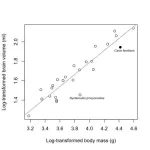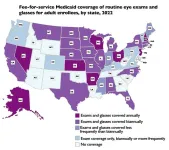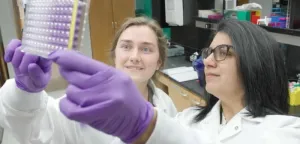(Press-News.org) By recruiting the immune system to combat tumor cells, immunotherapy has improved survival rates, offering hope to millions of cancer patients. However, only about one in five people responds favorably to these treatments.
With a goal of understanding and addressing immunotherapy’s limitations, researchers at Washington University School of Medicine in St Louis have found that the immune system can be its own worst enemy in the fight against cancer. In a new study in mice, a subset of immune cells – type 1 regulatory T cells, or Tr1 cells – did its normal job of preventing the immune system from overreacting but did so while inadvertently restraining immunotherapy’s cancer-fighting power.
“Tr1 cells were found to be a heretofore unrecognized obstacle to immunotherapy’s effectiveness against cancer,” said senior author Robert D. Schreiber, PhD, the Andrew M. and Jane M. Bursky Distinguished Professor in the Department of Pathology & Immunology, and director of the Bursky Center for Human Immunology & Immunotherapy at Washington University School of Medicine. “By removing or circumventing that barrier in mice, we successfully reenergized the immune system’s cancer-fighting cells and uncovered an opportunity to expand the benefits of immunotherapy for more cancer patients.”
The study is available in Nature.
Cancer vaccines represent a new approach to personalize cancer immunotherapy. Aimed at the mutant proteins specific to a patient’s tumor, such vaccines induce killer T cells to attack tumor cells while leaving healthy cells unharmed. Schreiber’s group previously showed that more effective vaccines also activate helper T cells, another immune cell type, that recruit and expand additional killer T cells to destroy the tumors. But when they tried to add increased amounts of the helper T cell target to supercharge the vaccine they found they generated a different type of T cell that inhibited rather than promoted tumor rejection.
“We tested the hypothesis that by increasing helper T cell activation we would induce enhanced elimination of the sarcoma tumors in mice,” said first author Hussein Sultan, PhD, an instructor in pathology & immunology. So he injected groups of tumor bearing mice with vaccines that activated killer T cells equally while triggering a different degree of helper T cell activation.
Much to the researchers’ surprise in this latest study, the vaccine meant to hyperactivate helper T cells produced the opposite effect and inhibited tumor rejection.
“We thought that more helper T cell activation would optimize elimination of the sarcoma tumors in mice,” Sultan said. “Instead, we found that vaccines containing high doses of helper T cell targets induced inhibitory Tr1 cells that completely blocked tumor elimination. We know that Tr1 cells normally control an overactive immune system, but this is the first time they have been shown to dampen its fight against cancer.”
Tr1 cells normally put the brakes on the immune system to prevent it from attacking the body’s healthy cells. But their role in cancer has not been seriously explored. Looking through previously published data, the researchers found that tumors from patients who had responded poorly to immunotherapy had more Tr1 cells compared with tumors of patients who had responded well. The number of Tr1 cells also increased in mice as tumors grew bigger, rendering the mice insensitive to immunotherapy.
To bypass the inhibiting cells, the researchers treated the vaccinated mice with a drug that enhances killer T cells’ fighting power. The drug, developed by biotechnology startup Asher Biotherapeutics, carries modifications in the immune-boosting protein called interleukin 2 (IL-2) that specifically revs up killer T cells and reduces the toxicity of unmodified IL-2 treatments. The additional boost from the drug overcame Tr1 cells’ inhibition and rendered the immunotherapy more effective.
“We are committed to personalizing immunotherapy and broadening its effectiveness,” said Schreiber. “Decades of researching basic tumor immunology have expanded our understanding of how to trigger the immune system to achieve the most robust antitumor response. This new study adds to our understanding of how to improve immunotherapy to benefit more people.”
As co-founder of Asher Biotherapeutics – which provided the mouse version of the modified IL-2 drugs – Schreiber is indirectly involved in the company’s clinical trials testing the human version of the drug as a monotherapy in cancer patients. If successful, the drug has the potential to be tested in combination with cancer treatment vaccines.
END
Drug bypasses suppressive immune cells to unleash immunotherapy
Mouse study addresses problem of immune system self-sabotaging cancer treatments
2024-08-06
ELSE PRESS RELEASES FROM THIS DATE:
Treatment with smoke can favor seed germination in the Cerrado
2024-08-06
For thousands of years, plants have evolved in the presence of wildfires in the Cerrado, Brazil’s savanna-like biome. Scientists at São Paulo State University (UNESP) studied the effect of smoke on seed germination for 44 plant species typical of the Cerrado, as reported in an article published in Plant Ecology, where they stress that their findings could be used to optimize the restoration of degraded areas.
The study was conducted by PhD candidate Gabriel Schmidt Teixeira Motta under the supervision of Rosana Marta Kolb, a professor at UNESP.
“Previous studies focused on the effect of smoke on only a few ...
Medicaid vision coverage for adults varies widely by state
2024-08-06
A study supported by the National Institutes of Health (NIH) shows that 6.5 million Medicaid enrollees (12%) lived in states without coverage for routine adult eye exams; and 14.6 million (27%) resided in states without coverage for eyeglasses. The study based on 2022-23 coverage policies, published in Health Affairs, is among the first to provide a comprehensive, state-by-state analysis of adult Medicaid benefits for basic vision services in both fee-for-service and managed care.
Medicaid provides health coverage to millions of Americans, including eligible low-income adults, children, pregnant women, elderly ...
Chemical and nutritional profile of fruit, vegetables and co-produts to improve human health
2024-08-06
A new study emphasizes the vital role of fruits, vegetables, and their co-products in boosting human health and life expectancy. Packed with minerals, vitamins, and dietary fiber, these foods help prevent chronic diseases. Antioxidants in fruits and vegetables, such as vitamins and carotenoids, combat harmful free radicals.
Interested in more information and in contributing to the topic, visit: bit.ly/46zTKFX
Combining various fruits like oranges, apples, grapes, and blueberries enhances antioxidant effects. Diets rich in these foods can lower blood pressure, reduce heart disease and ...
Better cancer trial representation begins with speaking one’s language
2024-08-06
NEW YORK, NY (July 29, 2024) ---- Underrepresentation of racial and ethnic minority populations in cancer clinical trials persists partly because translation and interpretation services and resources are unavailable or inadequate in the United States, according to a Children’s Oncology Group (COG) study led by Columbia University School of Nursing. The updated study was published online in the Journal of the National Cancer Institute Cancer Spectrum on July 25, 2024 and will appear in the August 2024 journal issue.
In 2019, 68 million people in the United States were reported to speak a language other than ...
Social and structural factors are key drivers of disparities in obesity rates
2024-08-06
Obesity is an epidemic in the United States. It has been increasing among adults of all races and ethnicities over the last two decades; however, obesity is higher among Non-Hispanic Black adults, Hispanic adults, and American Indian or Alaska Native adults, than their White and Asian counterparts, according to the National Institutes of Health. Adults with lower income also have higher risk of obesity than those with a high income.
A George Mason University College of Public Health team of interprofessional researchers analyzed the last five years ...
New study helps global MNCs weigh the pros and cons of implementing blockchain technology
2024-08-06
Blockchain technology has become one of the most hyped advancements in recent years, but there hasn’t been a clear understanding of the potential trade-offs for its use by multinational corporations (MNCs). A new study published in the Global Strategy Journal provides a better understanding of blockchain merits and drawbacks by focusing on three particular applications of the technology in this sector: financial transactions, collaboration, and data analytics.
The study, “A perspective on three trade-offs of blockchain technology for the global strategy of the MNC,” was authored by Tuuli Hakkarainen of the University of Liverpool, Anatoli Colicev of the University ...
Increased ventilation not effective in reducing influenza virus spread in play-based model, Emory study finds
2024-08-06
Increasing ventilation in child-care settings may not always be effective at preventing flu virus spread, according to a new study published by a team of researchers at Emory University, University of Pittsburgh School of Medicine, and Virginia Tech.
The spread of flu viruses is commonly studied in animal models that don’t mimic the real-life scenarios of the human experience, making it difficult to evaluate strategies that will be effective in common places where disease spreads rapidly, such as childcare settings. As reported online and in a coming print issue of the journal Proceedings of the National ...
Lonely people tend to have more nightmares, Oregon State University research shows
2024-08-06
CORVALLIS, Ore. – People who are lonely are more apt to have bad dreams, according to a collaboration that included an Oregon State University scientist.
The findings are important because both loneliness and sleep disorders are serious public health issues, said OSU’s Colin Hesse. They are connected to increased risk of heart disease, stroke and premature death.
In a paper published in the Journal of Psychology, Hesse and researchers at the University of Arizona, the University of Tampa and Whitworth University note that stress ...
UC Irvine-led team reveals how TREM2 genetic mutation affects late-onset Alzheimer’s
2024-08-06
Irvine, Calif., Aug. 6, 2024 — Researchers led by the University of California, Irvine have discovered how the TREM2 R47H genetic mutation causes certain brain areas to develop abnormal protein clumps, called beta-amyloid plaques, associated with late-onset Alzheimer’s disease. Leveraging single-cell Merfish spatial transcriptomics technology, the team was able to profile the effects of the mutation across multiple cortical and subcortical brain regions, offering first-of-their-kind insights at the single-cell level.
The study, recently published online in the journal Molecular Psychiatry, compared the brains of normal mice and special mouse models that undergo ...
Considering the patient’s perspective in inducible laryngeal obstruction care
2024-08-06
Inducible laryngeal obstruction is a breathing disorder characterized by unwanted vocal fold closure having the potential to restrict breathing at times.
It’s estimated that between 3-12% of patients with dyspnea complaints have inducible laryngeal obstruction.
Patients with inducible laryngeal obstruction are thought to make up to 22% of patients with frequent emergency room visits due to sudden onset dyspnea.
While experts know how to treat the condition, there’s not much formal research about what patients with the disorder experience ...
LAST 30 PRESS RELEASES:
Beyond small data limitations: Transfer learning-enabled framework for predicting mechanical properties of aluminum matrix composites
Unveiling non-thermal catalytic origin of direct current-promoted catalysis for energy-efficient transformation of greenhouse gases to valuable chemicals
Chronic breathlessness emerging as a hidden strain on hospitals
Paleontologists find first fossil bee nests made inside fossil bones
These fossils were the perfect home for ancient baby bees
Not everyone reads the room the same. A new study examines why.
New research identifies linked energy, immune and vascular changes in ME/CFS
Concurrent frailty + depression likely boost dementia risk in older people
Living in substandard housing linked to kids’ missed schooling and poor grades
Little awareness of medical + psychological complexities of steroid cream withdrawal
Eight in 10 trusts caring for emergency department patients in corridors, finds BMJ investigation
NASA’s Webb telescope finds bizarre atmosphere on a lemon-shaped exoplanet
The gut bacteria that put the brakes on weight gain in mice
Exploring how patients feel about AI transcription
Category ‘6’ tropical cyclone hot spots are growing
Video: Drivers struggle to multitask when using dashboard touch screens, study finds
SLU research shows surge in alcohol-related liver disease driving ‘deaths of despair’
Rising heat reshapes how microbes break down microplastics, new review finds
Roots reveal a hidden carbon pathway in maize plants
Membrane magic: FAMU-FSU researchers repurpose fuel cells membranes for new applications
UN Member States pledge to increase access to diagnosis and inhaled medicines for the 480 million people living with COPD
Combination therapy shows potential to treat pediatric brain cancer ATRT
Study links seabird nesting to shark turf wars in Hawai‘i
Legal sports betting linked to sharp increases in violent crime, study finds
Breakthrough AI from NYUAD speeds up discovery of life-supporting microbes
New Eva Mayr-Stihl Foundation funding initiative boosts research at University of Freiburg on adaptation of forests to global change
The perfect plastic? Plant-based, fully saltwater degradable, zero microplastics
Bias in data may be blocking AI’s potential to combat antibiotic resistance
Article-level metrics would provide more recognition to most researchers than journal-level metrics
Satiety’s little helper: Protein that supports appetite regulating protein identified
[Press-News.org] Drug bypasses suppressive immune cells to unleash immunotherapyMouse study addresses problem of immune system self-sabotaging cancer treatments





